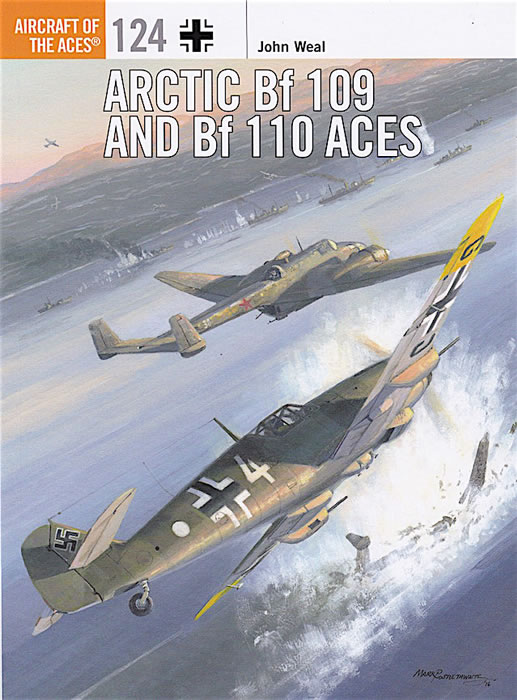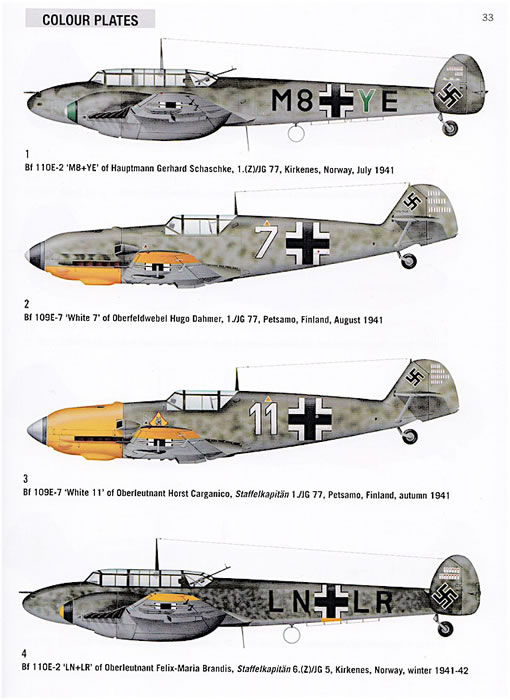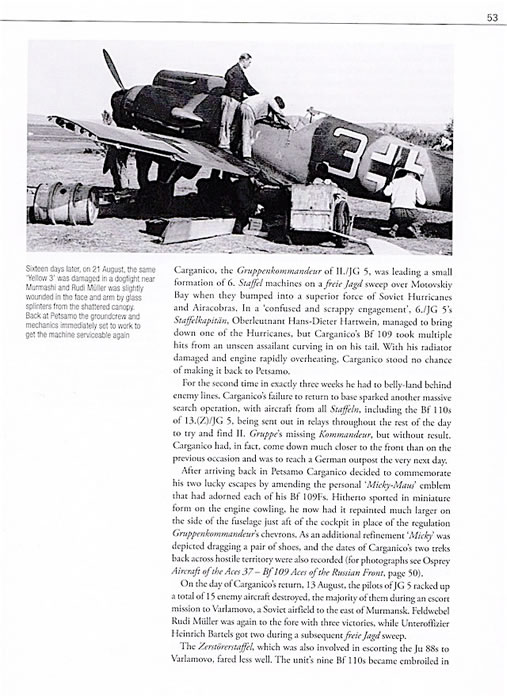Arctic Bf 109
and Bf 110 Aces

Osprey Publishing
S u m m a r y : |
Title and ISBN: |
Osprey Publishing
Arctic Bf 109 and Bf 110 Aces
by John Weal, illustrated by Chris Davey
ISBN: 978-1-78200-798-2 |
Contents & Media: |
Soft-cover format; 112 pages; black and white photographs; full-colour plates. |
Price: |
£13.99 plus postage available online from Osprey Publishing, and from specialist book and hobby shops.
Also available from Osprey as an ePub (ePub or PDF) for £11.99
• ePub (ISBN 978-1-78200-800-2) and
• PDF (ISBN 978-1-78200-799-9) |
Review Type: |
First Read. |
Advantages: |
Well structured, written and illustrated. |
Disadvantages: |
|
Conclusion: |
Highly recommended to anyone who is interested in modelling the aircraft of, or otherwise learning about, this little known corner of the Luftwaffe’s war in Russia. |
Reviewed by Brad Fallen

HyperScale is proudly supported by Squadron
The air war over Russia’s far north between 1941 and 1944 produced more than 100 German Bf 109 and Bf 110 aces. The conflict was a microcosm of the Luftwaffe’s overall experience in the East, with outnumbered German pilots prevailing through superior skills and equipment. Ultimately however a steady attrition of men and resources, combined with growing Russian strength, led to strategic failure and the German fighter force’s withdrawal into Norway in November 1944.

This story is well told by John Weal in Osprey’s 124th Aircraft of the Aces volume. Weal covers the war chronologically, devoting a chapter to each year from 1941 to 1944. The victories and losses of Jagdgeschwader 5 and other units are related from the viewpoints of aces who destroyed hundreds of Soviet aircraft. Many of the latter were US and British lend lease machines, including obsolescent types such as Hamptons and Hurricanes that soldiered on into 1943 and beyond.
One of the defining characteristics of the Luftwaffe’s Arctic war was the static ground front, which compared to the vast movements further south barely shifted in three years. Most Bf 109 and Bf 110 efforts, particularly in the early years, went towards reducing Murmansk’s viability as a port – an objective the Soviets had no option but to resist, even if it cost them dearly in men and aircraft.

There are familiar stories here of the unpleasant fate of Luftwaffe fliers who fell into Russian hands, along with less well known – but surprisingly frequent – cases of shot-down Germans who successfully evaded capture and returned to base. Weal also gives examples of German pilots who convinced their captors they would spy for Russia and as a result were returned to their units; of course once back they did nothing of the sort!
The chronological chapters are followed by two appendices: the first a list of the decorations awarded to members of JG 5 during or for their service in the Arctic, and the second a list of JG 5’s Arctic aces. Running to nearly three pages in length, it is topped by Heinrich Ehrler and Walter Schuck with 171 victories each.
Illustrations are a combination of black and white period photos and colour port view profiles. The photos are well chosen and of generally good quality but quite small, which makes it difficult to pick out some of the detail. The 32 profiles, by Chris Davey, are good impressions of the aircraft in question. They are also well captioned, both on the page and in a linked descriptive section at the end of the book, which is helpful for anyone who wants to do further research.
This book filled a gap in my knowledge of the Luftwaffe’s Russian war.
Well structured, written and illustrated, I can recommend it highly to anyone interested in modelling the aircraft or otherwise learning about this little known campaign.
Highly Recommended
Thanks to Osprey Publishing for the sample.
Review Copyright © 2016 by Brad Fallen
This Page Created on 24 February, 2017
Last updated
18 April, 2017
Back to HyperScale Main Page
Back to Reviews Page

|
